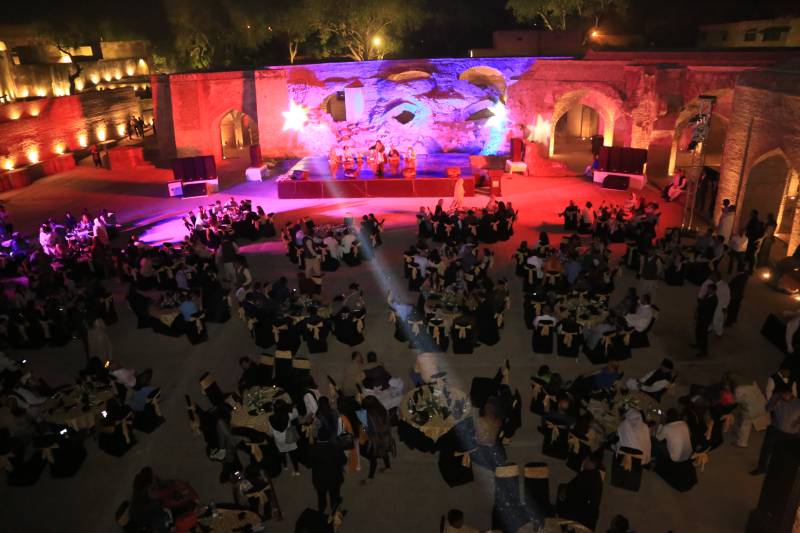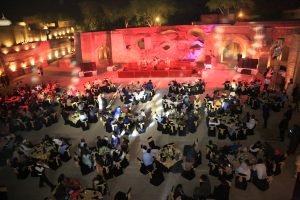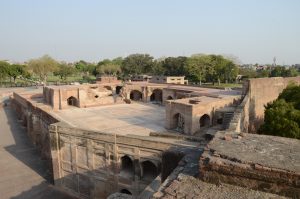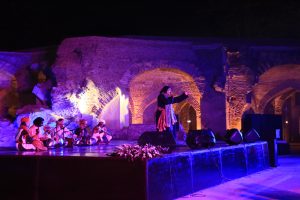
Tania Qureshi writes about the recently-restored Royal Kitchen of Lahore Fort which was once an aromatic area where enticing cuisines were cooked for royals and aristocracy that lived in or visited the Lahore Fort.
If you ever happened to visit the Royal Kitchen many years ago, you must be thinking where it is now. These kitchens are located behind Alamgiri Gate and you’ll see them as you climb up the royal ramp while entering the fort through British-era Postern Gate.
You will find these kitchens on your right. A narrow passage will lead you to these kitchens and as you enter, you will be awe-stunned with its exquisiteness and open courtyard.
This Royal Kitchen also known as Shahi Bawarchikhana or Matbakh Shahi (in Arabic) was once the aromatic area – filled with enticing cuisines being cooked for the royals and aristocracy that resided or visited the Lahore Fort. The history of the building articulating, that it was one of the most utilised buildings at the time of the Mughals. It was the center of all majestic festivities.
Royal Kitchens were built during the reign of Mughal Emperor Shah Jahan. It was where the food and delicious cuisines with special Mughal recipes and spices used from Akbari Mandi were prepared along with a huge variety of drinks and sweets.
The helpers in their gaudy dresses, head gears and fine crockery, would carry the food from the kitchen to the chambers of the king, queen, princes, princesses and other courtiers.
Any emperor or nobles of the neighbouring areas were also served with food cooked in this very kitchen. But who knew it would be in shambles after the Mughals. The special ornamented pots for cooking and catering were used in Royal Kitchen i.e. Shub Deg, Khas Dan, Taftan, Samwar, ornamented glasses for water, shurbat and Lassi were used and very much famous among other areas of the sub-continent.
According to old references and maps, the Royal Kitchens of the Mughal era had a balanced rectangular courtyard which was created in the middle with four-sided structures. The Temple of Prince Loh was located at northwest corner of Royal Kitchens while there were indications of a well which might have been constructed to supply water to the kitchens.
The Arches were opened and well-connected while an entrance to one of the kitchens was located in the middle of north wall for the purpose of serving to the Royal Palaces specially the Sheesh Mahal.
As the Sikh took over the Lahore Fort, the Royal Kitchens were damaged along with many other structures inside the Fort. This kitchen was vandalised the most I think. It was converted into a food and grain store room and at the same time it was converted into a stable for horses and other animals. The kitchen was no more – who knew it would be lost under the dust of times!
According to some historians, once Maharaja Ranjeet Singh – while visiting the Royal Kitchens – came across a goat which was to be slaughtered for cooking. Suddenly the goat ran towards Maharaja and started bleating upon which the Maharaja felt pity and ordered the chef to release the goat. Some historians also claim that the kitchen remained in the same use. It is also said that a Gulab Khana at the back side of Royal Kitchens was made which was the part of Huzoori Bagh. This Gulab Khana was meant as a pharmaceutical center where special vine was prepared for Maharaja Ranjeet Singh.
Then the British Raj took over the fort and later in 1856 the Royal Kitchens met another use. This place was named “Special Jail” by the British. Prisons and torture cells were made there and rooms were added in the building for the officers. The Royal Kitchen was converted into an interrogation cell during the British period and it remained like that until 1985.
The British made several municipal changes in building. An upper floor was added for residential and official purposes. The outer historic wall was supported by providing 18 numbers of inclined heavy buttresses.
These interventions are still complementing in distribution of building loads and safeguarding historic walls from deterioration.
During the same era, the eastern and southern levels were raised and a new lime floor around building was laid down. The north east corner of Royal Kitchen was converted into ramp for the purpose of giving access to the building. A sewage system, water and electric supply lines were also laid during this period.

According to British era Map of Lahore Fort Royal Kitchens were converted into storage and godowns some of the areas were converted for different uses like workshop, storage, infantry barracks etc.
During the same time, there were not many political or personal rivalries by the British, but this jail served those who were a part of freedom movement. Many of the freedom fighters were put into this special jail and tortured to death. This place was known for torturing and many people dreaming of freedom lost their lives in this jail. The first Prime Minister of India Jawahar Lal Nehru and few members of his cabinet were also imprisoned in this jail.
Finally Pakistan became an independent state in 1947, but the use of jail did not end with the British Raj, rather it increased. The only difference this Jail saw was the change of prisoners.
Once it had the freedom fighters as prisoners and later it had the political and personal rivals of our influential and politicians. Most of the prisoners in this Jail were the Indian agents right after partition till the two wars between India and Pakistan.
During the war of 1971, some prisoners escaped from this jail, a few were caught back but some were able to cross the border.

Some of the important personalities that remained imprisoned in this Special Jail were Zulfiqar Ali Bhutto Prime Minister of Pakistan, Wali Khan head of a political party, Samlan Taseer Governor Punjab, Hanif Ramay Chief Minister Punjab, Agha Shorash Kashmiri Jouranlist, Akbar Bugti Baloch Leader, Molana Abdul Sattar Niazi leader of Pakistan Movement, Maulana Mododi, Tufail Muhammad of Jamat –e- Islami, Zia Shahid journalist, Muhammad Khan Daku and many political workers and politicians of different political parties.
Till many years, this place was used for torturing people because of personal vendettas. Many died of the torture, some became mentally ill and disabled, and some escaped but were caught by different diseases.
Nobody could ever get over with the tortures they met with in this jail. Lahore Fort had become a tourist spot right after partition but who knew the ongoing stories in this Special Jail.
Established since 1856 for almost 132 years, this place was the king of torture cells. New torture techniques were practiced here every day but the peak time of torturing people and number of prisoners is associated with the Zia Regime. It is said by the sources that during Zia regime this place housed most of the prisoners than the previous era. Finally this cell was closed for such activities by Benazir Bhutto in 1988. She declared that no prisoner would be tortured there and thus a time of tranquility touched this cell as well.
In 2015, the conservation of the Royal Kitchens was taken up by the Walled City of Lahore Authority. Initially the photographic documentation was made and then came in the technical documentation using Total Stations and other tools.
The documentation revealed that according to the plan of Lahore fort a major portion of Royal Kitchen was missing while the eastern side had collapsed and turned into relics. During investigation and documentation phase of Royal Kitchen it was validated that the original entrance was located on northern wall in the approximate alignment of existing Musaman Darwaza which had also collapsed and its remains could be seen from the Royal Kitchens.

During British era, when the functions of building were changed, a new entrance was introduced from north east corner with gentle slope connected to courtyard than the arcaded rooms of kitchen though, the same entrance is functional to date.
The Conservation Wing of Walled City of Lahore Authority started the on ground conservation and initially took up the excavation process. During excavation, pots and pottery was also found. The most amazing thing revealed was the fresco wall of Temple of Prince Loh.
Special small bricks, kankar lime plaster and other mortars were prepared which were to be used in this conservation. The structures were strengthened and the missing ones were re-built as the available references.
Royal Kitchens or Shahi Bawarchi Khana, an astounding revelation inside Lahore Fort, has fascinated many who are now visiting the Fort. A ‘no go area’ inside the fort has surprisingly altered into ‘a tourist spot’ but still many are unaware of the magnificence of this undetected portion inside the magnificent Fort of Lahore.
You will see a mesmerizing structure now conserved aesthetically and delicately by the Walled City of Lahore Authority.
Walled City of Lahore Authority holds cultural evenings and gathering at Royal Kitchens now and soon it will be converted into a Mughal themed restaurant.
The royal kitchens in the Lahore Fort were inaugurated by Prime Minister Imran Khan on 4th May 2019.
If you ever happened to visit the Royal Kitchen many years ago, you must be thinking where it is now. These kitchens are located behind Alamgiri Gate and you’ll see them as you climb up the royal ramp while entering the fort through British-era Postern Gate.
You will find these kitchens on your right. A narrow passage will lead you to these kitchens and as you enter, you will be awe-stunned with its exquisiteness and open courtyard.
This Royal Kitchen also known as Shahi Bawarchikhana or Matbakh Shahi (in Arabic) was once the aromatic area – filled with enticing cuisines being cooked for the royals and aristocracy that resided or visited the Lahore Fort. The history of the building articulating, that it was one of the most utilised buildings at the time of the Mughals. It was the center of all majestic festivities.
Royal Kitchens were built during the reign of Mughal Emperor Shah Jahan. It was where the food and delicious cuisines with special Mughal recipes and spices used from Akbari Mandi were prepared along with a huge variety of drinks and sweets.
The helpers in their gaudy dresses, head gears and fine crockery, would carry the food from the kitchen to the chambers of the king, queen, princes, princesses and other courtiers.
Any emperor or nobles of the neighbouring areas were also served with food cooked in this very kitchen. But who knew it would be in shambles after the Mughals. The special ornamented pots for cooking and catering were used in Royal Kitchen i.e. Shub Deg, Khas Dan, Taftan, Samwar, ornamented glasses for water, shurbat and Lassi were used and very much famous among other areas of the sub-continent.
According to old references and maps, the Royal Kitchens of the Mughal era had a balanced rectangular courtyard which was created in the middle with four-sided structures. The Temple of Prince Loh was located at northwest corner of Royal Kitchens while there were indications of a well which might have been constructed to supply water to the kitchens.
The Arches were opened and well-connected while an entrance to one of the kitchens was located in the middle of north wall for the purpose of serving to the Royal Palaces specially the Sheesh Mahal.
As the Sikh took over the Lahore Fort, the Royal Kitchens were damaged along with many other structures inside the Fort. This kitchen was vandalised the most I think. It was converted into a food and grain store room and at the same time it was converted into a stable for horses and other animals. The kitchen was no more – who knew it would be lost under the dust of times!
According to some historians, once Maharaja Ranjeet Singh – while visiting the Royal Kitchens – came across a goat which was to be slaughtered for cooking. Suddenly the goat ran towards Maharaja and started bleating upon which the Maharaja felt pity and ordered the chef to release the goat. Some historians also claim that the kitchen remained in the same use. It is also said that a Gulab Khana at the back side of Royal Kitchens was made which was the part of Huzoori Bagh. This Gulab Khana was meant as a pharmaceutical center where special vine was prepared for Maharaja Ranjeet Singh.
Then the British Raj took over the fort and later in 1856 the Royal Kitchens met another use. This place was named “Special Jail” by the British. Prisons and torture cells were made there and rooms were added in the building for the officers. The Royal Kitchen was converted into an interrogation cell during the British period and it remained like that until 1985.
The British made several municipal changes in building. An upper floor was added for residential and official purposes. The outer historic wall was supported by providing 18 numbers of inclined heavy buttresses.
These interventions are still complementing in distribution of building loads and safeguarding historic walls from deterioration.
During the same era, the eastern and southern levels were raised and a new lime floor around building was laid down. The north east corner of Royal Kitchen was converted into ramp for the purpose of giving access to the building. A sewage system, water and electric supply lines were also laid during this period.

According to British era Map of Lahore Fort Royal Kitchens were converted into storage and godowns some of the areas were converted for different uses like workshop, storage, infantry barracks etc.
During the same time, there were not many political or personal rivalries by the British, but this jail served those who were a part of freedom movement. Many of the freedom fighters were put into this special jail and tortured to death. This place was known for torturing and many people dreaming of freedom lost their lives in this jail. The first Prime Minister of India Jawahar Lal Nehru and few members of his cabinet were also imprisoned in this jail.
Finally Pakistan became an independent state in 1947, but the use of jail did not end with the British Raj, rather it increased. The only difference this Jail saw was the change of prisoners.
Once it had the freedom fighters as prisoners and later it had the political and personal rivals of our influential and politicians. Most of the prisoners in this Jail were the Indian agents right after partition till the two wars between India and Pakistan.
During the war of 1971, some prisoners escaped from this jail, a few were caught back but some were able to cross the border.

Some of the important personalities that remained imprisoned in this Special Jail were Zulfiqar Ali Bhutto Prime Minister of Pakistan, Wali Khan head of a political party, Samlan Taseer Governor Punjab, Hanif Ramay Chief Minister Punjab, Agha Shorash Kashmiri Jouranlist, Akbar Bugti Baloch Leader, Molana Abdul Sattar Niazi leader of Pakistan Movement, Maulana Mododi, Tufail Muhammad of Jamat –e- Islami, Zia Shahid journalist, Muhammad Khan Daku and many political workers and politicians of different political parties.
Till many years, this place was used for torturing people because of personal vendettas. Many died of the torture, some became mentally ill and disabled, and some escaped but were caught by different diseases.
Nobody could ever get over with the tortures they met with in this jail. Lahore Fort had become a tourist spot right after partition but who knew the ongoing stories in this Special Jail.
Established since 1856 for almost 132 years, this place was the king of torture cells. New torture techniques were practiced here every day but the peak time of torturing people and number of prisoners is associated with the Zia Regime. It is said by the sources that during Zia regime this place housed most of the prisoners than the previous era. Finally this cell was closed for such activities by Benazir Bhutto in 1988. She declared that no prisoner would be tortured there and thus a time of tranquility touched this cell as well.
In 2015, the conservation of the Royal Kitchens was taken up by the Walled City of Lahore Authority. Initially the photographic documentation was made and then came in the technical documentation using Total Stations and other tools.
The documentation revealed that according to the plan of Lahore fort a major portion of Royal Kitchen was missing while the eastern side had collapsed and turned into relics. During investigation and documentation phase of Royal Kitchen it was validated that the original entrance was located on northern wall in the approximate alignment of existing Musaman Darwaza which had also collapsed and its remains could be seen from the Royal Kitchens.

During British era, when the functions of building were changed, a new entrance was introduced from north east corner with gentle slope connected to courtyard than the arcaded rooms of kitchen though, the same entrance is functional to date.
The Conservation Wing of Walled City of Lahore Authority started the on ground conservation and initially took up the excavation process. During excavation, pots and pottery was also found. The most amazing thing revealed was the fresco wall of Temple of Prince Loh.
Special small bricks, kankar lime plaster and other mortars were prepared which were to be used in this conservation. The structures were strengthened and the missing ones were re-built as the available references.
Royal Kitchens or Shahi Bawarchi Khana, an astounding revelation inside Lahore Fort, has fascinated many who are now visiting the Fort. A ‘no go area’ inside the fort has surprisingly altered into ‘a tourist spot’ but still many are unaware of the magnificence of this undetected portion inside the magnificent Fort of Lahore.
You will see a mesmerizing structure now conserved aesthetically and delicately by the Walled City of Lahore Authority.
Walled City of Lahore Authority holds cultural evenings and gathering at Royal Kitchens now and soon it will be converted into a Mughal themed restaurant.
The royal kitchens in the Lahore Fort were inaugurated by Prime Minister Imran Khan on 4th May 2019.
